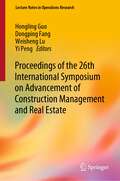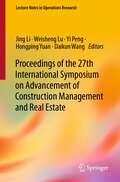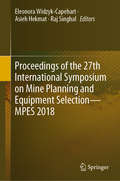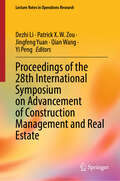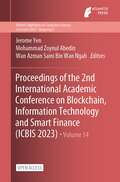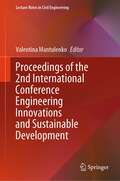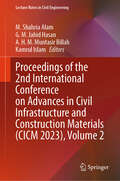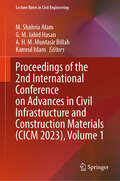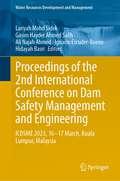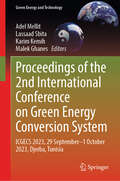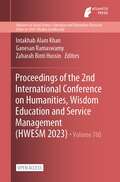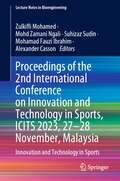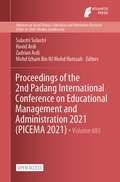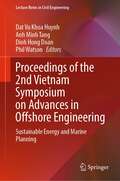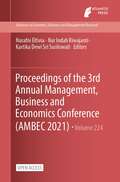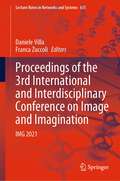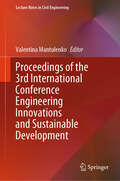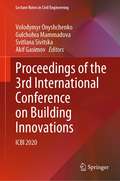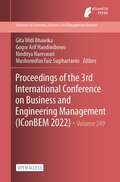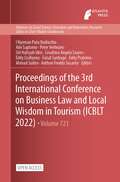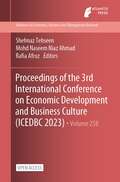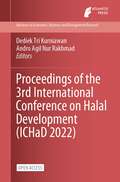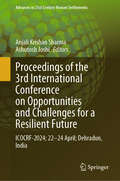- Table View
- List View
Proceedings of the 25th International Symposium on Advancement of Construction Management and Real Estate
by Xinhai Lu Zuo Zhang Weisheng Lu Yi PengThis proceedings book focuses on innovation, cooperation, and sustainable development in the fields of construction management and real estate. The book provides a detailed analysis and description of the disciplinary frontiers in the field of building management and real estate and how they can be promoted in the context of the epidemic. A wide variety of papers provide a reference value for both scholars and practitioners. The proceedings book is the documentation of “the 25th International Symposium on Advancement of Construction Management and Real Estate” (CRIOCM 2020), which was held at the School of Public Administration, Central China Normal University, Wuhan, China, in 2020.
Proceedings of the 26th International Symposium on Advancement of Construction Management and Real Estate (Lecture Notes in Operations Research)
by Yi Peng Weisheng Lu Hongling Guo Dongping FangThis book of CRIOCM 2021 (26th International Conference on Advancement of Construction Management and Real Estate) presents the latest developments in real estate and construction management around the globe. The conference was organized by the Chinese Research Institute of Construction Management (CRIOCM) working in close collaboration with Tsinghua University. Written by international academics and professionals, the book discusses the latest achievements, research findings and advances in frontier disciplines in the field of construction management and real estate. Covering a wide range of topics, including building information modeling, big data, geographic information systems, housing policies, management of infrastructure projects, intelligent construction and smart city, real estate finance and economics and urban planning and sustainability, the discussions provide valuable insights into the implementation of advanced construction project management and real estate market in China and abroad. The book offers an outstanding resource for academics and professionals.
Proceedings of the 27th International Symposium on Advancement of Construction Management and Real Estate (Lecture Notes in Operations Research)
by Jing Li Weisheng Lu Yi Peng Hongping Yuan Daikun WangThis book presents the proceedings of CRIOCM 2022 (27th International Conference on Advancement of Construction Management and Real Estate), sharing the latest developments in real estate and construction management around the globe. The conference was organized by the Chinese Research Institute of Construction Management (CRIOCM) working in close collaboration with The Chinese University of Hong Kong. Written by international academics and professionals, the book discusses the latest achievements, research findings, and advances in frontier disciplines in the field of construction management and real estate. Covering a wide range of topics, including spatial planning and land use innovation, integration and application of BIM and GIS, low-carbon built environment, post-pandemic resilient cities development, housing and social governance, real estate market and urban policy, real estate finance and economics, intelligent construction and smart city, built environment for healthy living, and construction management in the post-COVID-19 era, the discussions provide valuable insights into the implementation of advanced construction project management and real estate market in China and abroad. The book offers an outstanding resource for academics and professionals
Proceedings of the 27th International Symposium on Mine Planning and Equipment Selection - MPES 2018
by Eleonora Widzyk-Capehart Asieh Hekmat Raj SinghalThis proceedings book presents research papers discussing the latest developments and findings in the fields of mining, machinery, automation and environmental protection. It includes contributions from authors from over 20 countries, with backgrounds in computer science, mining engineering, technology and management, and hailing from the government, industry and academia. It is of interest to scientists, engineers, consultants and government staff who are responsible for the development and implementation of innovative approaches, techniques and technologies in the mineral industries. Covering the latest advances in fundamental research, it also appeals to academic researchers.
Proceedings of the 28th International Symposium on Advancement of Construction Management and Real Estate (Lecture Notes in Operations Research)
by Dezhi Li Patrick X. W. Zou Jingfeng Yuan Qian Wang Yi PengThis book presents the proceedings of CRIOCM 2023, sharing the latest developments in real estate and construction management around the globe. The conference was organized by the Chinese Research Institute of Construction Management (CRIOCM) and Southeast University. Written by international academics and professionals, the proceedings discuss the latest achievements, research findings and advances in frontier disciplines in the field of construction management and real estate, covering a wide range of topics, including new theory and practice of engineering management, smart construction and maintenance, green low-carbon building and sustainable development, big data and blockchain, construction and real estate economy, real estate finance and investment, real estate management and housing policy, innovative theory and practice of urban governance, land use and urban planning, and other related issues. The discussions provide valuable insights into the implementation of advanced construction project management and real estate market in China and abroad. The book offers an outstanding resource for academics and professionals.
Proceedings of the 2nd International Academic Conference on Blockchain, Information Technology and Smart Finance (Atlantis Highlights in Computer Sciences #14)
by Jerome Yen Mohammad Zoynul Abedin Wan Azman Saini Bin Wan NgahThis is an open access book.With the rapid development of modern economy and Internet technology, the traditional financial industry has to develop Internet finance to provide better services and meet the needs of the times. It is against this background that the blockchain, relying on its special advantages (collective maintenance, reliable databases, and decentralization), provides the reliability to solve the credit risk of Internet finance, has an impact on institutions, trust mechanisms, risk control, etc. in the Internet finance industry, and has derived more new application scenarios, thus paving the way for the development of finance in the Internet era.Applying blockchain technology to the financial field can promote data information sharing, improve value transmission efficiency, and enhance database security. The financial market based on the decentralized system of blockchain technology can reduce the operating costs of financial institutions, improve economic efficiency, and solve problems such as information asymmetry. The new financial business model of "blockchain+finance" is conducive to improving the Internet credit reporting system, preventing and controlling Internet financial risks, and further realizing "financial disintermediation". At present, in China's financial field, blockchain technology has been applied and innovated in supply chain finance, cross-border payment, trade finance, asset securitization and other scenarios.To promote the exchange and development of blockchain, information technology and financial experts and scholars. The 2nd International Academic Conference on Blockchain, Information Technology and Smart Finance (ICBIS 2023) will be held in Hangzhou from February 17 to 19, 2023. This conference mainly focuses on the latest research on "blockchain, information technology and smart finance". This conference brings together experts, scholars, researchers and relevant practitioners in this field from all over the world to share research results, discuss hot issues, and provide participants with cutting-edge scientific and technological information, so that you can timely understand the development trends of the industry and master the latest technologies, broaden research horizons and promote academic progress.
Proceedings of the 2nd International Conference Engineering Innovations and Sustainable Development (Lecture Notes in Civil Engineering #378)
by Valentina MantulenkoThis book presents the contributions from the 2nd International Conference Engineering Innovations and Sustainable Development, held in Samara, Russia on April 20–21, 2023. By presenting international research on various sustainability issues, it includes topics such as current trends in industrial and agricultural development, innovations in the construction and transport sectors, problems concerning the financing of innovative activities and governmental support for innovations, and engineering competences and skills in the era of new technologies. It also covers the economic, environmental, and informational aspects of sustainable development in the context of innovations. Finally, the book addresses theoretical and practical aspects by studying the phenomenon of sustainability and engineering development in terms of comparing international experiences. It provides significant value for scientists, teachers, and students of higher educational institutions, and specialists, who are researching sustainable development issues in the era of engineering innovations.
Proceedings of the 2nd International Conference on Advances in Civil Infrastructure and Construction Materials (Lecture Notes in Civil Engineering #512)
by M. Shahria Alam G. M. Jahid Hasan A. H. M. Muntasir Billah Kamrul IslamThis book presents select proceedings of the International Conference on Advances in Civil Infrastructure and Construction Materials (CICM) and provides a compendium of cutting-edge research and innovative solutions in civil engineering from around the world. This book covers a diverse range of topics from seismic resilience and smart infrastructure technologies to novel construction materials and sustainable design practices. The papers discuss the application of shape memory alloys and innovative bracing systems designed for enhanced seismic resilience; delve into advancements in low-calcium fly ash, geopolymer binders, and sustainable mix designs that promise lower environmental impacts; provide insights into the latest in structural health monitoring and AI applications that revolutionize maintenance and safety protocols; showcase the use of recycled materials in construction, advancements in low-carbon cementitious composites, and innovative waste treatment technologies; review detailed studies on the behavior of composite structures under various loads and the application of machine learning in predicting structural integrity; and show how civil engineering practices impact urban development, from transportation planning to disaster resilience. The information and data-driven inferences compiled in this book are therefore expected to be useful for practitioners, policymakers, educators, researchers, and individual learners interested in civil engineering and allied fields.
Proceedings of the 2nd International Conference on Advances in Civil Infrastructure and Construction Materials (Lecture Notes in Civil Engineering #511)
by M. Shahria Alam G. M. Jahid Hasan A. H. M. Muntasir Billah Kamrul IslamThis book presents select proceedings of the International Conference on Advances in Civil Infrastructure and Construction Materials (CICM) and provides a compendium of cutting-edge research and innovative solutions in civil engineering from around the world. This book covers a diverse range of topics from seismic resilience and smart infrastructure technologies to novel construction materials and sustainable design practices. The papers discuss the application of shape memory alloys and innovative bracing systems designed for enhanced seismic resilience; delve into advancements in low-calcium fly ash, geopolymer binders, and sustainable mix designs that promise lower environmental impacts; provide insights into the latest in structural health monitoring and AI applications that revolutionize maintenance and safety protocols; showcase the use of recycled materials in construction, advancements in low-carbon cementitious composites, and innovative waste treatment technologies; review detailed studies on the behavior of composite structures under various loads and the application of machine learning in predicting structural integrity; and show how civil engineering practices impact urban development, from transportation planning to disaster resilience. The information and data-driven inferences compiled in this book are therefore expected to be useful for practitioners, policymakers, educators, researchers, and individual learners interested in civil engineering and allied fields.
Proceedings of the 2nd International Conference on Dam Safety Management and Engineering: ICDSME 2023, 16—17 March, Kuala Lumpur, Malaysia (Water Resources Development and Management)
by Lariyah Mohd Sidek Gasim Hayder Ahmed Salih Ali Najah Ahmed Ignacio Escuder-Bueno Hidayah BasriThis book presents peer-reviewed articles from the 2nd International Conference on Dam Safety Management and Engineering (ICDSME 2023), organized by the Malaysian National Committee on Large Dams (MYCOLD), Tenaga Nasional Berhad (TNB), Department of Irrigation and Drainage (DID) and Universiti Tenaga Nasional (UNITEN). With the theme “resilient dams for resilient communities,” the conference highlights dam safety and engineering issues by together dam professionals and experts around the world to discuss, reflect and share their experiences in addressing these issues.
Proceedings of the 2nd International Conference on Green Energy Conversion System: ICGECS 2023, 29 September–1 October 2023, Djerba, Tunisia (Green Energy and Technology)
by Adel Mellit Lassaad Sbita Karim Kemih Malek GhanesThis book presents peer reviewed articles from the 2nd International Conference on Green Energy Conversion Systems held in Djerba, Tunisia, from 13–15 September 2023. It brings together researchers and professionals from all over the world to share and discuss recent advancements and developments in renewable energy and its applications and foster future collaboration tending towards zero carbon.
Proceedings of the 2nd International Conference on Humanities, Wisdom Education and Service Management (Advances in Social Science, Education and Humanities Research #760)
by Intakhab Alam Khan Ganesan Ramaswamy Zaharah Binti HussinThis is an open access book.The 2nd International Conference on Humanities, Wisdom Education and Service Management(HWESM 2023)will be held in Shanghai, China from March 10 to 12, 2023. The purpose of the conference is to provide an international platform for experts, scholars, engineers and technicians, and technical R&D personnel engaged in related fields such as "humanities", "wisdom education" and "service management", to share scientific research results, broaden research ideas, collide with new ideas, and strengthen academic research, and to explore the key challenges and research directions faced by the development of this field, and promote the industrialization cooperation of academic achievements. Experts, scholars, business people and other relevant personnel from universities and research institutions at home and abroad are cordially invited to attend and exchange.
Proceedings of the 2nd International Conference on Innovation and Technology in Sports, ICITS 2023, 27–28 November, Malaysia: Innovation and Technology in Sports (Lecture Notes in Bioengineering)
by Alexander Casson Zulkifli Mohamed Mohd Zamani Ngali Suhizaz Sudin Mohamad Fauzi IbrahimThis book compiles the proceedings of ICITS 2023 that comprehensively includes diverse technological facets within the realm of Sports Engineering and Technology. The book encompasses various specialized tracks, including instrumentation, materials, data analytics, biomechanics, simulation, equipment design, and performance analysis, among others. A deeper understanding of the pivotal challenges encountered and technological breakthroughs achieved in the pursuit of enhancing sporting performance is deliberated. The readers are expected to gain insights into prevailing trends, pertinent issues, ameliorative factors, cutting-edge technological innovations, and proposed remedies, thereby further enriching their knowledge of this multidisciplinary field.
Proceedings of the 2nd Padang International Conference on Educational Management and Administration 2021 (Advances in Social Science, Education and Humanities Research #683)
by Sulastri Sulastri Havid Ardi Zadrian Ardi Mohd Izham bin HJ Mohd HamzahThis is an open access book.2nd PICEMA invites academic practitioners, university lecturers and students, independent scholars and researchers to present their research abstracts and papers. Contributions on unpublished results of empirical and experimental research in areas of educational management are cordially invited for presentation. The aims of this conference are: Sharing and discussing critical issues in educational management by stakeholders, lecturers, practitioners, students, researchers or stakeholders.Identifying various policies in the field of education management to produce quality education.Discussing various innovations, practical challenges and the best solutions in education managementGathering scientists and educational experts in scientific forums.Providing some opportunities for innovators to produce various educational technologies.
Proceedings of the 2nd Vietnam Symposium on Advances in Offshore Engineering: Sustainable Energy and Marine Planning (Lecture Notes in Civil Engineering #208)
by Dat Vu Khoa Huynh Anh Minh Tang Dinh Hong Doan Phil WatsonThis book gathers a selection of refereed papers presented at the 2nd Vietnam Symposium on Advances in Offshore Engineering (VSOE 2021), held in 2022 in Ho Chi Minh City, Vietnam. The book consists of articles written by researchers, practitioners, policymakers, and entrepreneurs addressing the important topic of technological and policy changes intended to promote renewable energies and to generate business opportunities in oil and gas and offshore renewable energy. With a special focus on sustainable energy and marine planning, the book brings together the latest lessons learned in offshore engineering, technological innovations, cost-effective and safer foundations and structural solutions, environmental protection, hazards, vulnerability, and risk management. Its content caters to graduate students, researchers, and industrial practitioners working in the fields of offshore engineering and renewable energies.
Proceedings of the 3rd Annual Management, Business and Economics Conference (Advances in Economics, Business and Management Research #661)
by Nurafni Eltivia Nur Indah Riwajanti Kartika Dewi Sri SusilowatiThis is an open access book.The online conference hosted by the State Polytechnic of Malang. This online conference aims (1) to bring together the researchers and practitioners, students, and civil society organization representatives in the scientific forum; (2) to share and to discuss theoretical and practical knowledge about innovation in Management, Business and Economics. Specifically, this conference can be used as a scientific forum for accommodating discussion among researchers in the field of business, management and economics science. The theme is Digital Business Transformation and Information System: The Way Forward.
Proceedings of the 3rd International and Interdisciplinary Conference on Image and Imagination: IMG 2021 (Lecture Notes in Networks and Systems #631)
by Daniele Villa Franca ZuccoliThis book gathers peer-reviewed papers presented at the 3rd International and Interdisciplinary Conference on Image and Imagination (IMG), held in Milano, Italy, in November 2021. Highlighting interdisciplinary and multi-disciplinary research concerning graphics science and education, the papers address theoretical research as well as applications, including education, in several fields of science, technology and art. Mainly focusing on graphics for communication, visualization, description and storytelling, and for learning and thought construction, the book provides architects, engineers, computer scientists, and designers with the latest advances in the field, particularly in the context of science, arts and education.
Proceedings of the 3rd International Conference Engineering Innovations and Sustainable Development (Lecture Notes in Civil Engineering #540)
by Valentina MantulenkoThis book presents the contributions from the 3rd International Conference Engineering Innovations and Sustainable Development, held in Samara, Russia on April 26, 2024. By presenting international research on various sustainability issues, it includes topics such as current trends in industrial and agricultural development, innovations in the construction and transport sectors, problems concerning the financing of innovative activities and governmental support for innovations, and engineering competences and skills in the era of new technologies. It also covers the economic, environmental, and informational aspects of sustainable development in the context of innovations. Finally, the book addresses theoretical and practical aspects by studying the phenomenon of sustainability and engineering development in terms of comparing international experiences. It provides significant value for scientists, teachers, and students of higher educational institutions, and specialists, who are researching sustainable development issues in the era of engineering innovations.
Proceedings of the 3rd International Conference on Building Innovations: ICBI 2020 (Lecture Notes in Civil Engineering #181)
by Volodymyr Onyshchenko Gulchohra Mammadova Svitlana Sivitska Akif GasimovThis book gathers the latest advances, innovations, and applications in the field of building design and construction, by focusing on new design solutions for buildings and new technologies creation for construction, as presented by researchers and engineers at the 3rd International Conference Building Innovations (ICBI), held in Poltava – Baku, Ukraine – Azerbaijan, on June 1-2, 2020. It covers highly diverse topics, including structures operation, repairing and thermal modernization in existing buildings and urban planning features, machines and mechanisms for construction, as well as efficient economy and energy conservation issues in construction. The contributions, which were selected by means of a rigorous international peer-review process, highlight numerous exciting ideas that will spur novel research directions and foster multidisciplinary collaborations.
Proceedings of the 3rd International Conference on Business and Engineering Management (Advances in Economics, Business and Management Research #249)
by Gita Widi Bhawika Gogor Arif Handiwibowo Ninditya Nareswari Mushonnifun Faiz SugihartantoThis is an open access book. The 3rd International Conference on Business and Engineering Management (IConBEM 2022) will be held by using the theme of Leveraging Sustainable Digital Economy, Entrepreneurship, and Future Energy Systems role in the post COVID-19 Era. The emergence of COVID-19 has brought changes to the world of business and the economy. The massive growth of the digital economy, emergence of new business trend, and acceleration of technological development in the short period of time will have impact to society . This conference will bring together ideas, knowledge, problems, research findings, and expert experiences surrounding the leveraging of those rapid and massive change to give benefit for society.
Proceedings of the 3rd International Conference on Business Law and Local Wisdom in Tourism (Advances in Social Science, Education and Humanities Research #721)
by I Nyoman Putu Budiartha Ade Saptomo Peter Verhezen Siti Hafsyah Idris Cesaltina Angela Soares Eddy Lisdiyono Faisal Santiago Eddy Pratomo Ahmad Sudiro Anthon Freddy SusantoThis is an open access book. The 3rd International Conference on Business Law and Local Wisdom in Tourism (ICBLT) will be an annual event hosted by Universitas Warmadewa, Denpasar, Bali. “Business Law and Local Wisdom in Tourism” has been chosen at the main theme for the conference, with a focus on the latest research and trends, as well as future outlook of the field of Call for paper fields to be included in ICBLT 2022 are Local Wisdom (Customary Law); Law on Business, Business Competition, and Prohibition of Monopoly; Law on Land and Environment; Law on Investment; Law on Criminal Act of Corruption and Asset Recovery Law on Licenses and Labor; Law on Tourism; Law on Transportation; Law on Immigration Intellectual Property Rights; and Law on Resolution of Tourism Investment and Business Disputes.This international seminar aims to facilitate scholars, researchers, practitioners, and students to share their thoughts on the latest trends on Business Law and Local Wisdom in Tourism whilst building network in an engaging environment. The participants of this conference will have a chance to enrich knowledge and discuss common challenges and offer creative solutions. By this, we hope to enhance and contribute knowledge for a better civilized community.
Proceedings of the 3rd International Conference on Economic Development and Business Culture (Advances in Economics, Business and Management Research #258)
by Shehnaz Tehseen Mohd Naseem Niaz Ahmad Rafia AfrozThis is an open access book.The 3rd International Conference on Economic Development and Business Culture (ICEDBC 2023) will be held in Dali on June 30–July 2, 2023.ICEDBC 2023 is annual conference since 2021. It was held in Xiamen, Dali from 2021 to 2022. Every year, there are many attendees from Asia, Europe, America, etc., and quite a few well-known experts give plenary speeches.Business culture is an organic and important part of the social culture system, it is the comprehensive reflection and expression of national culture and modern consciousness in business behavior, and is formed under the influence of national culture and modern consciousness with modern business characteristics and group consciousness as well as the behavior norms generated by this consciousness.For business, one hand on the economy, the other on culture, will certainly promote China's business towards modernization in a big step. The day when business culture is flourishing is the day when business economy is flourishing.Business culture plays a fundamental and decisive role in economic development, providing adequate basic support and supporting services for business activities.Business culture regulates business behavior, regulates business relationships, and influences the way of thinking in economic operation.Business culture promotes economic development through the shaping of people's pattern realm, entrepreneurship and integrity spirit.Business culture plays the role of "adhesive, catalyst and lubricant" for economic development by constructing and practicing value creation in business management and business transactions.ICEDBC2023 aims to explore the role of business culture in promoting economic development and to thoroughly analyze how to use its economic functions more effectively.ICEDBC 2023 warmly invite you to participate in and look forward to seeing you in Dali, China.
Proceedings of the 3rd International Conference on Environmentally Sustainable Animal Industry 2022 (Advances in Biological Sciences Research #28)
by Eko Widodo Vu Dinh Ton Rugang Tian Norsida Man Mashudi MashudiThis is an open access book.The 3rd ICESAI aims to discuss issues related to the development of an eco-friendly and sustainable livestock industry using smart farming which is related to scientific research and how it is applied. The 3rd ICESAI offers opportunities for the for researchers and the livestock industry from all over the world to share experiences, learn and expand networking on several matters relating to the development of a sustainable and environmentally friendly livestock industry, especially with the implementation of smart farming.
Proceedings of the 3rd International Conference on Halal Development (Advances in Economics, Business and Management Research #246)
by Dediek Tri Kurniawan Andro Agil Nur RakhmadThis is an open access book.INTERNATIONAL CONFERENCE ON HALAL DEVELOPMENT “THE TREND OF GREEN ECONOMICS ON HALAL INDUSTRY: UNVEILING CURRENT AND FUTURE PROSPECT”.We invite all professors, researchers, students, practitioners, and other halal industry enthusiasts to participate in The International Conference on Halal Development to present, share, and discuss the halal industry phenomenon depicted by academic research result as a strategic way to enlarge and enhance the development of halal industry together.
Proceedings of the 3rd International Conference on Opportunities and Challenges for a Resilient Future: ICOCRF-2024; 22–24 April; Dehradun, India (Advances in 21st Century Human Settlements)
by Anjali Krishan Sharma Ashutosh JoshiThis book presents peer-reviewed articles from the 3rd International Conference on Opportunities and Challenges for a Resilient Future (ICOCRF 2024) held at Dehradun, India. In recent times, the world has faced unprecedented challenges affecting its inhabitants adversely. Natural disasters, climate change, and pandemic have affected public health and food securities causing economic and social disruption that has placed millions of livelihoods at great risk. It is the need of the hour to strategize and mitigate these challenges and provide solutions for the consequences of these calamities and to align with SDG goals in delivering a meaningful progress for people and the world by creating a brighter future for all. In alignment with the recent emergencies faced by global communities and sustainable development goals, this book brings with it the relevant dialogues to address the above.

